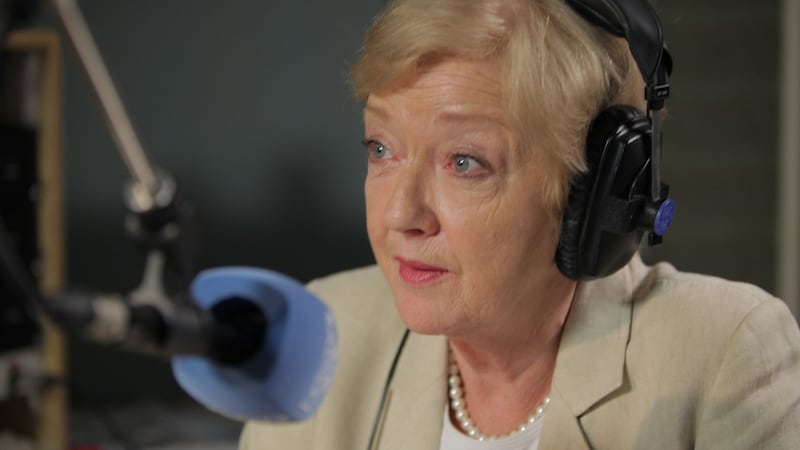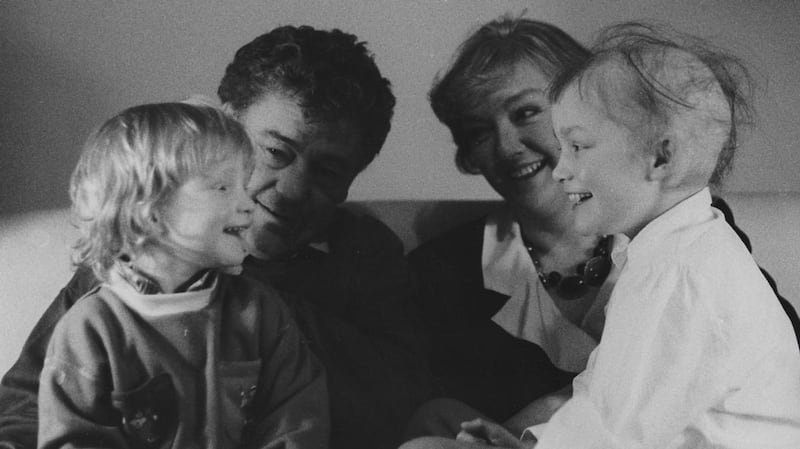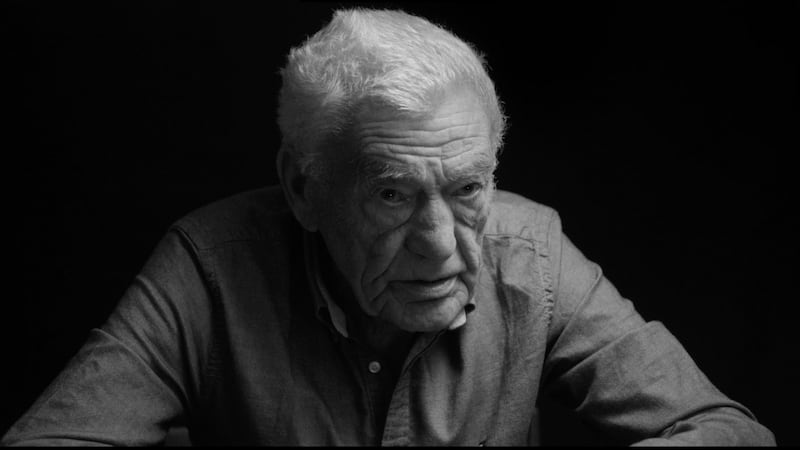“Life changes fast. Life changes in the instant. You sit down to dinner and life as you know it ends” – Joan Didion, The Year of Magical Thinking
If her father was still alive, Marian Finucane used to say to John Clarke, Clarke would never have got his feet under the table.
And it’s a fair bet that in early 1970s Ireland, Garda sergeant Daniel Finucane would have taken a dim view of the gabby 40-year-old with the lived-in face, a taste for the drink and a glint in the eye that hinted at all kinds of devilment and disruption. Not to mention the married status, the three boys and the slow horses. Or that the sergeant’s daughter was in her early 20s, 14 years younger than her swain and was married herself.
Forty years on, the swain holds his hands up. "I was irresponsible by the metrics of the time. I met her when she was 20. She was a budding protesting type of architect and ended up working for my best friend who was Arthur Gibney." The attraction was immediate and powerful but they agreed to go their separate ways. Three or four years later, they met again on Gibney's stairs. They decided to go for a drink.
“I remember so well walking down the road and she said I’m worried about that biography of Hemingway, and I defended Mr Hemingway. I think she was in her crusading feminist mood at the time,” he says, amused at the memory, as fascinated by her now as he was then.
That's half a lifetime ago now. At 84, he is a man laid bare by loss and grief. But on a grizzly day in Co Kildare, amid the chain smoking, the endless cups of tea (he gave up alcohol decades ago), the sidebars on geopolitics, history, the qualities of cement and the origin of Zen gardens (Pope Urban IX, knights and samurai are involved), the wry humour, blazing curiosity, love of gossip and free-flowing chat are intact.

Marian’s spirit is channelled through impish wooden sculptures and colourful wall hangings from faraway adventures. It flows through his fierce pride in her and his four attentive sons – three from his first marriage, one from his and Marian’s – and the “distraction” projects begun with her: a Dublin cottage restoration and a rather beautiful, ambitious Zen garden project that keep him occupied.
“I’m addicted to cement. I’ve a lot of addictions but cement is one I’ll take. It’s something to carry me along because I was sort of lost. . . my touchstones were gone. I suppose you have to reorientate yourself like the old homing pigeon who flies round in circles till you find the right direction. . .”
But the touchstones remain elusive. He wonders constantly who or what he is now. How does he perceive himself any more without “my Marian, the woman I have loved for 40 years”, who “made the colours brighter, the world a bit easier to live in”, as he put it at her funeral Mass a year ago. “I find myself so powerless at the moment. I truly don’t know what to do.”
About a month after the funeral he rang their son Jack and said he needed to change this. He wanted to throw a party. A bit soon perhaps? “There were pitfalls, disasters but it had been a wonderful life. There was something to be celebrated. Then Covid-19 stepped in . . .”
Documentary
Four months after that thwarted plan, we see him being interviewed for Patrick Farrelly and Kate O'Callaghan's documentary, to be broadcast on RTÉ television on January 4th, sitting at the kitchen table, the rugged topography of his face and unflinching gaze captured in black-and-white close-up, a cigarette often dangling from his lips as he ruminates on the fallout.
“A huge part of my life has gone and a huge part of that for us was talk. Now I sit.” He didn’t like radio or television any more, he said, and couldn’t focus enough to read.
“I don’t think you can explain your grief to anybody. What you see with me now is the tip of the iceberg. You see tears, sorrow and there’s a big lump under that that’s very personal. I don’t want to talk about it. I don’t understand it. And I hope that somewhere in that morass is a coping mechanism and I hope to find it. But . . . my tears don’t solve it.”
Yet his fluent, clear-eyed take on a life with Marian anchors the film. He talks about their “irresponsible” ways, her early influences and extraordinary reach across the spectrum of Irish society, about her values and work ethic, about how she remained sane as their eight-year-old daughter Sinéad faded away with leukaemia.
While John did the first hospital shift of the day with Sinéad, Marian would present her programme and drive home to do the second. “I would think that was the hardest drive she ever did.”
Bone marrow donated by John seemed to work for a while. But when the cancer returned, they had to make the shattering decision to discontinue treatment. “We decided: no more torture, live out your life – and she had a ball . . . But you could measure her decline like a slow hourglass running out. Marian never recovered from her death. She wouldn’t visit the grave. I don’t think she could.”
Through Marian’s journalism, Farrelly’s film also becomes a canter across 40 years of Irish social history, replete with startling Liveline views from another era, iconic interviews and being read off the altar by enraged priests. It comes spliced with images from that charmed life that she and John were building together, running an open house on a Westmeath farm where he kept the “slow horses” and eight or nine children were always running around the place, plus two more as he puts it, in the shape of Nell (McCafferty) and Nuala (O’Faolain).

The documentary-making must have been a useful distraction in the early stages? “No,” he says now. “There has been nothing else in my head except my loss and how I’m going to cope with it and what I’m going to do. How do I define my life, how do I live out the rest of it? There are no words that make any sense to anybody except me about my loss . . . I’m still very much lost. I occupy myself with these daft things which I have no great interest in one way or another.”
He struggles to articulate the difference between the before and after. “I can’t tell you what it is – because I don’t want to live like this. I want to live with Marian but I can’t . . . I’m still running around trying to think of who am I? Or what am I? Or am I defined by my partner? Or do we define ourselves as an individual or what? And strangely enough that’s not a sad thought; it’s a practical sort of thought. I say to myself: ‘What am I doing all this stuff for?’ And I have no answer.
“But she and I had planned an entirely different retirement. And in the immediate few months after her death I felt terribly sorry for myself and then I began to think: I feel really sorry for Marian because she was really looking forward to this, because it was going to be great crack and she’d worked hard all her life and this was the sunset walk that was going to be full of all sorts of – well, we have the capacity to get ourselves into trouble . . . and places where ‘Jaze we’ll go and have a look . . .’”
He still can’t watch television or listen to radio. In that other life, the listening and viewing never stopped. “Look, I lived with a news hen. Radio on here, Al Jazeera over there, CNN and BBC down there. I knew every nook and cranny of the global enterprise. Can’t do it since.”
Travel
In that other life there were travels to extraordinary places, often driven by his madcap notions drilled out of history or the Bible – such as the pair of them horse-riding across the desert in six days while trying to figure out why it took Moses 40 years; or travelling through Russia “thinking about Russia the way Russians think about Russia”; visiting India, chatting hour after hour about the competing ideologies of China and India, him and her with different approaches but a deep curiosity about “how societies work, what’s the narrative here, what do we know, what’s the truth?”
In the end, maybe the “difference” between the before and after is as mundane as the chit-chat and the shorthand language – “a nod, a frown, an eyebrow” – developed over years, that couples are hardly aware of until it’s gone. “We had talked endlessly, we chattered. We actually read a lot together, in total silence. But we seem to have chatted a lot. I didn’t realise how much we chatted.” He doesn’t remember a raised voice, never mind a fight, in 40 years. “Maybe I’m suffering from amnesia but I can’t remember one. Why would we?”
He notes the sceptical gaze from this end of the table. “See, we were both married before – and that puts manners on ya. American women say: ‘Always marry a married man.’ It’s like two old mill wheels, they begin to smooth down a little, you know? I think both of us would be peacemakers rather than warmakers . . . We disagreed on many things – how I parked the car would be a major one, or where my clothes lay on the floor as distinct from where hers lay on the floor – but I think we agreed far more often.”
The pain caused by a "crazy" chemistry and a love that destroyed two marriages is freely acknowledged. "Marian and I felt a tremendous guilt. Someone said we were like two 15-year-olds obsessed with each other and never grew up. I've talked to my sons about it. And I talked to them back then a lot about it."
A mountain farm he had bought in north Mayo was sold "to be with Marian". He made his money "on bits and pieces here and there", always "a bit involved in property", as well as running the Irish International advertising agency for 20 years. "I sort of retired somewhat and we bought a farm in Westmeath [which came with a beautiful, rickety early Georgian house called Reynella], so she could work and I could do my farming thing." Farming? "A lot of slow horses," he says with his wry grin.

That was followed by a move to a farm in Co Kildare that straddles the old Pale. It came with a Victorian house “with no inside”, reputedly Flurry Knox’s lodge in The Irish RM television series. As soon as the restoration was complete, they decided it was too small “to accommodate the bandwagon of comedians we knocked around with” so they built another, bigger house in the woods “as you would”.
The boy grew up and left. Then eight or nine years ago, while carrying a tray down the stairs, Marian fell and broke both legs, which led to the construction of the current warm, bright home built on the flat “where you can’t fall”.
Outside, the Zen garden is under creation, a vast hole (where two Hymac excavators have already “disappeared”) marking the site of a man-made lake fed by a rushing stream, a host of cherry trees, shrubs and saplings from various vistas that will take decades to mature.
Arrhythmic heart
He talks about Marian’s death as a quirk in the order of things – “I should have gone first” – but also as something almost foretold. “I believe for two years that she had been very unwell. We had discussed it but it was more me being annoyed with her. . . She wouldn’t go to doctors, and I’d say, I’ll go with you, I’ll do anything you want – and she’d say: ‘We’ll see where we are tomorrow.’
“She had a very peculiar attitude to the medical profession.” She even persuaded a sister to go along to a doctor and claim to have Marian’s ailments.
She had an arrhythmic heart that had failed to respond to corrective procedures. “She had a whole series of things. She really wanted to give up smoking but she couldn’t. When she finished a programme on a Sunday she was exhausted. She would go to the doctor eventually but it was always a year too late or 10 years too late . . . Her heart was the issue, aggravated by endless fags, chats, this that and the other. We were never logical in this family – we probably believed we were immortal. Which we’re not.”
She herself knew she was very unwell, he believes. And though they never had the conversation about death, “not in any real sense”, they did sign a living will with a solicitor a couple of years ago, listing a slew of calamitous circumstances under which one or other of them would agree “to pull out the plug”.
Her final broadcast was on December 8th, 2019. Her sign-off is replayed in the documentary and to a casual listener her breathing sounds laboured. But she and John and their son Jack were headed for India for a friend’s wedding and a great railway adventure. Another heart procedure had yielded poor results but she wouldn’t admit it, he says, because she wanted to go to India.
Arriving back in Dublin on a Monday after a long flight, she said she felt awful. He saw her off to bed, and next morning she seemed happily asleep when he left a cup of tea for her and headed for Dublin.
He believes now that she was dead by then. By the time he returned in the afternoon it was evident she was gone. “But when the paramedics said she was dead, I just stupidly said: ‘She just couldn’t be, will you check again?’”
The coroner’s verdict was pneumonia. John remains astonished by this, musing that Covid-19 was making its way across the world even then.
But the year of magical thinking when he believed Marian might come through the door is over. He used to have a breezy “chat” with Sinéad – gone over 30 years now – while passing the wonderful old cemetery where she is buried just down the road, but he almost averts his eyes now that Marian lies there with her. He cannot visit the grave.
And yet he is upright, to his surprise. His four sons ring every day.
The party is planned for the summer when the Zen garden will be revealed in all its glorious layers.
Life goes on.
Marian is on RTÉ One on Monday, January 4th, at 9.35pm. This article was edited on January 2nd













